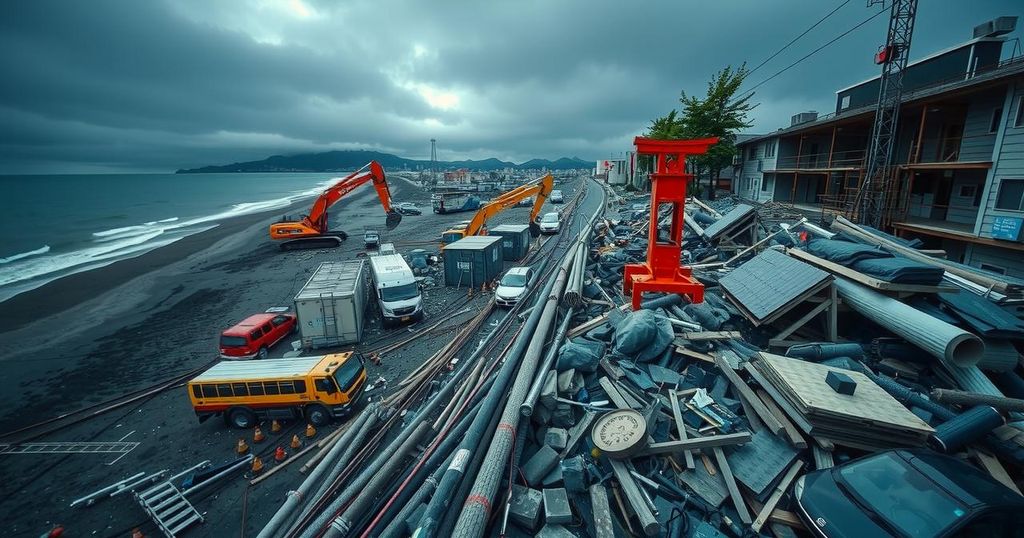The 2011 Japan Earthquake and Tsunami: Aftermath and Recovery Efforts
On March 11, 2011, Japan experienced a devastating earthquake and tsunami, leading to over 18,500 confirmed deaths and significant destruction, particularly in Miyagi Prefecture. The tsunami overwhelmed coastal areas, causing widespread loss of homes and infrastructure. Concurrently, a nuclear crisis unfolded at Fukushima Daiichi, where reactor failures resulted in radiation leaks, escalating to a severity rating comparable to the Chernobyl disaster. Recovery efforts have focused on rebuilding and reassessing safety protocols, with long-term implications for disaster preparedness in Japan.
The catastrophic earthquake and tsunami that struck Japan on March 11, 2011, profoundly impacted the nation, resulting in extensive loss of life and widespread destruction. Initially, reports indicated hundreds of casualties, with numbers escalating as the full extent of the disaster emerged. Within two weeks, the official death toll exceeded 10,000, with approximately 28,500 individuals confirmed as either dead or missing. The tragedy was marked by severe impacts, particularly in Miyagi Prefecture, which suffered the greatest losses with over 10,800 people killed or missing and thousands more injured. Most fatalities were attributed to drowning, and a significant proportion of the victims were elderly. In addition to the loss of life, the tsunami wreaked havoc along the Pacific coastline, overwhelming coastal cities and towns as well as extensive farmland, sweeping away houses, vehicles, and debris. While the tsunami accounted for most of the destruction, the earthquake itself also caused substantial damage, with significant fires breaking out in Sendai and other cities and thousands of homes destroyed across several prefectures. A critical concern following the disaster was the status of nuclear power plants in the Tōhoku region. Despite automatic shutdowns initiated by the earthquake, tsunami waves compromised cooling systems at the Fukushima Daiichi plant, leading to core meltdowns in several reactors. Exacerbated by hydrogen explosions, this situation prompted radiation leaks that resulted in a comprehensive evacuation and long-term concerns regarding radiation exposure in local food and water supplies. The nuclear accident was subsequently classified at a severity level of 7, equivalent to the Chernobyl disaster. In subsequent months, efforts were made to stabilize the Fukushima facility, and eventually, some evacuation zones were relaxed, allowing select residents to return. However, lingering concerns about contamination remained, and in December 2011, the Japanese Prime Minister declared the facility stable, although significant challenges persisted with regards to ongoing leaks and long-term mitigation of radioactive materials. This incident has since prompted Japan to reassess its nuclear policies and disaster preparedness strategies.
The 2011 Tohoku earthquake and tsunami marked one of the deadliest natural disasters in Japan’s history. The quake, registering at a magnitude of 9.0, generated a powerful tsunami that devastated the eastern coastline of Japan, affecting many cities and rural communities. This catastrophe led to substantial loss of life, with the official death toll reaching approximately 18,500 individuals, while additionally causing severe infrastructural damage and triggering a nuclear crisis at the Fukushima Daiichi power plant. Following the disaster, significant efforts were made for recovery, rebuilding, and reevaluating disaster preparedness to mitigate future risks. The impact of the tsunami highlighted vulnerabilities across various sectors, including emergency response, nuclear safety, and community resilience.
The 2011 Japan earthquake and tsunami resulted in profound consequences, including tragic loss of life, massive destruction of infrastructure, and a complex nuclear emergency at Fukushima. The disaster necessitated significant emergency response efforts and brought to light the importance of preparedness and resilience in the face of natural calamities. The recovery process continues to influence policy and practice in Japan, emphasizing the need for enhanced disaster management strategies. The legacy of the disaster has served as a critical reminder of the associated risks of living in a seismically active region and the necessity for rigorous safety measures, especially concerning nuclear facilities.
Original Source: www.britannica.com




Post Comment